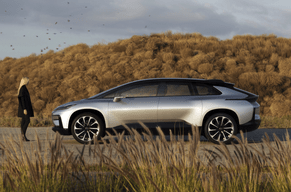 With CES 2017 going strong this week, we're taking a look at some of the tech trends that are evident at the show so far. There are lots of things going on at CES, but these are some of the big, overriding trends that look to have the ability to impact the market, both now and in the future. (Note: Much love to the great people at The Verge for the incredible reporting at CES this week. We've linked to many of their articles here and suggest you check out their great site on your own, too.) Trend #1 - Self-driving cars and the tech that drives them (no pun intended) Auto manufacturers and chipmakers seem to have caught on to what Tesla, Google, and, if rumors are to be believed, Apple, seem to have known for some time now - that self-driving cars are the future. It seems like everyone in the industry is racing (again, no pun intended) towards developing their own autonomous tech - in order to both be the first to market and the market leader. Chipmakers like Nvidia, Intel, and Mobileye are staking their claims to be the brains behind self-driving cars. And for good reason - with market saturation occurring in the mobile and desktop markets, getting a lot of expensive, complex chips and technology into every new car on the road in the next few years is the picture definition of creating new market opportunities. And Nvidia and Intel both have a lot to gain since their current fortunes are tied to the ever-declining desktop computing market. So witness their partnerships with everyone from Audi and BMW to traditional automotive suppliers like Bosch. Intel is even taking it a step further by investing in their own mapping technology for self-driving cars.
Not to be outdone, the traditional auto manufacturers seem to be, at long last, waking up to the need for both self-driving tech and for electric cars in general. Ford announced a surprisingly robust roadmap of electric and hybrid vehicles along with an autonomous version of its Fusion car. Chrysler and Toyota both rolled out wacky looking concept cars that will probably never be produced (although that Chrysler Portal minivan concept is probably about as cool as you’d ever be able to make a minivan). And Hyundai is pretty clearly targeting the lower end of the market with it’s Ioniq hatchback, which, thanks to “cheaper sensors and less computing power,” should make going driverless more affordable according to the company (although, personally, I’m not really sure if we’re already at the “cheaper and less powerful” stage where self-driving cars are involved). And Hyundai also managed to go straight off the deep end with a completely bonkers “Mobility Vision” concept of the smart home of the future paired with an autonomous vehicle that somehow becomes a part of your house. Make sure to check out the link, below, as it has to be seen to be believed.
Not surprisingly, the wireless carriers want a piece of the action as well since adding every single car on the road to the cellular networks should ensure a profitable new revenue stream for, well, probably as long as there continue to be cars on the road. AT&T, in particular, has decided to get out in front of the pack by partnering with the American Center for Mobility to “provide exclusive network resources needed to advance driverless technologies.” And last but certainly not least, long-in-gestation electric car startup Faraday Future (FF) took the wraps off their long-teased autonomous electric car, the oddly named FF91 (nine-one). The introduction presentation was apparently both weird and quite glitchy (the car refused to move for a self-parking demo, for example), but the specifications for the car are so insane as to be practically unbelievable. 130kWh batter, 378 miles of range, 1,050 horsepower, 0-60 in 2.39 seconds, full self-driving ability, facial recognition with self-opening doors in place of door handles, and so on. The downsides? Well, it’s pretty damn ugly (in my personal estimation) for one, and Faraday Future seems to be teetering on the edge of oblivion if the news of financial difficulties and recent executive turnover is accurate. I guess we’ll find out in 2018 when the FF91 supposedly goes into production for some yet to be announced (but surely insanely expensive) pricetag. Next up, we'll tackle the Internet of Things and "smart" devices. Comments are closed.
|
AuthorHi, I'm Todd, part of the MarketReady team. I write the blog, too. ArchivesCategories |
 RSS Feed
RSS Feed